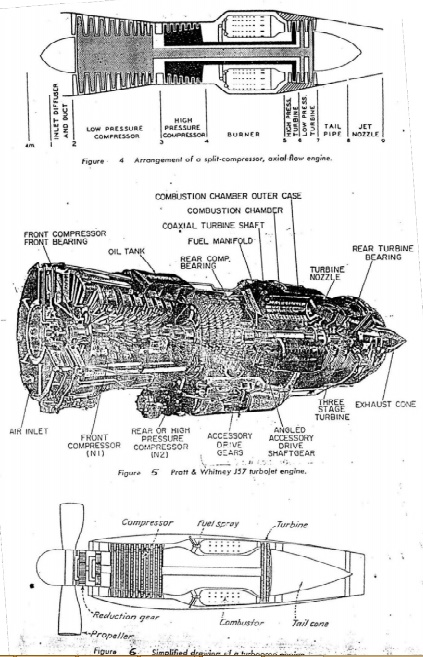Chapter: Mechanical : Gas Dynamics and Jet Propulsion : Jet Propulsion
Turboprop Engine (Propeller turbine, turbo-propeller, prop jet, turbo-prop)
Turboprop
Engine (Propeller turbine, turbo-propeller, prop jet,
turbo-prop)
For relatively high take-off thrust or for low-speed
cruise applications, turboprop engines are employed to accelerate a secondary
propellant stream, which is much larger than the primary flow through the
engine. The relatively low work input per unit mass of secondary air can be
adequately transmitted by a propeller. Though a ducted fan could also be used
for this purpose, a propeller is generally lighter compared to ducted fan could
also be used for this purpose, a propeller is generally lighter compared to
ducted fan engine and with variable pitch, it is capable of a wider range of
satisfactory performance.
In general, the turbine section of a turboprop
engine is very similar to that of a turbojet engine. The main difference is the
design and arrangement of the turbines. In the turbojet engine the turbine is
designed to extract only enough power from the high velocity gases to drive the
compressor, leaving the exhaust gases with sufficient velocity to produce the
thrust required of the engine. The turbine of the turboprop engine extracts
enough power from the gases to drive both the compressor and the propeller.
Only a small amount of power is left as thrust. Usually a turboprop engine has
two or more turbine wheels. Each wheel takes additional power from the jet
stream, with the result that the velocity of the jet is decreased
substantially.
Figure 6 shows a schematic diagram of a turboprop
engine. The air enters the diffuser as in a turbojet and is compressed in a
compressor before passing to the combustion chamber. The compressor in the
turboprop is essentially an axial flow compressor. The products of combustion
expand in a two-stage or multistage turbine. One stage of the turbine drives
the compressor and the other drives the propeller.
Thus
the turbine expansion is used to drive both compressor as well as propeller and
less energy is available for expansion in the nozzle. Due to lower speeds of
propeller a reduction gear is necessary between turbine and the propeller.
About 80 to 90% of the available energy in exhaust is extracted by the turbine
while rest, about 10 to 20%,
contributes the thrust
by increasing the exhaust jet velocity.
Total
thrust = jet thrust + propeller thrust
Turboprop engines combine in them the high take-off
thrust and good propeller efficiency of the propeller engines at speeds lower
than 800 km/h and the small weight, lower frontal area and reduced vibration
and noise of the pure turbojet engine.
Its
operational range is between that of the propeller engines and turbojets though
it can operate in any speed up to 800 km/h.



The power developed by the turboprop remains almost
same at high altitudes and high speeds as that under sea-level and take-off
conditions because as speed increases ram effect also increases. The specific
fuel consumption increases with increase in speed and altitude. The thrust
developed is high at take-off and reduces at increased speed.
Advantages
Turboprop engines have a higher thrust at take-off and better fuel economy.
Ø The
frontal area is less than air screw so that drag is reduced.
Ø 3.The
turboprop can operate economically over a wide range of speeds ranging from low
speeds, where pure jet engine is uneconomical, to speeds of about 800 km/h
where the propeller engine efficiency is low.
Ø It
is easy to maintain and has lower vibrations and noise.
Ø The
power output is not limited as in the case of propeller engines (air screw).
Ø The
multicast arrangement allows a great flexibility of operation over a wide range
of speeds.
Disadvantages
Ø The
main disadvantage is that at high speeds due to shocks and flow separation, the
propeller efficiency decreases rapidly, thereby, putting up a maximum speed
limit on the engine.
It requires
a reduction gear
which increases the
cost and also consumes certain energy developed by the
turbine in addition to requiring more space.
Related Topics